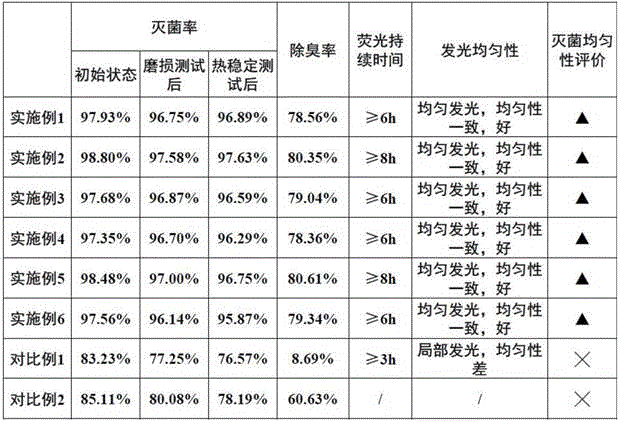Noctilucent deodorant ceramic glaze and preparation method thereof
A technology of ceramic glaze and deodorant, applied in the field of ceramics, can solve the problems of limited application scope, unsatisfactory effect, and lack of multiple functions.
- Summary
- Abstract
- Description
- Claims
- Application Information
AI Technical Summary
Problems solved by technology
Method used
Image
Examples
Embodiment 1
[0031] A luminous deodorizing ceramic glaze and a preparation method thereof, the preparation method comprising the following steps:
[0032] Step A, preparing low-temperature frit: by mass percentage, 10% potassium nitrate, 7% quartz, 10% potassium feldspar, 5% albite feldspar, 10% spodumene, 30% boric acid, 5% barium carbonate, 8% fluorite, 3% kaolin, 2% sodium fluoride and 10% functional agent are mixed evenly, after sieving, grinding and mixing, they are calcined at 1250-1300°C and then rapidly quenched to obtain a melting temperature of 650-800°C. Low temperature frit;
[0033] Step B, preparing luminous deodorant glaze slurry: by mass percentage, 30% low-temperature frit, 30% potassium feldspar, 10% quartz, 5% calcite, 8% talc, 4% calcium phosphate, 5% kaolin, 8 % Calcined soil is mixed to obtain mixed powder, add functional agent to the mixed powder and mix evenly, finely grind to 300~350 mesh, then add water to obtain glaze slurry and adjust the specific gravity of gl...
Embodiment 2
[0046] A luminous deodorizing ceramic glaze and a preparation method thereof, the preparation method comprising the following steps:
[0047] Step A, preparing low-temperature frit: by mass percentage, 8% potassium nitrate, 8% quartz, 10% potassium feldspar, 6% albite, 11% spodumene, 32% boric acid, 4% barium carbonate, 7% fluorite, 2% kaolin, 4% sodium fluoride and 8% functional agent are mixed evenly, after sieving, grinding and mixing, they are calcined at 1250-1300°C and then rapidly quenched to obtain a melting temperature of 650-800°C. Low temperature frit;
[0048] Step B, preparing luminous deodorant glaze slurry: by mass percentage, 25% low-temperature frit, 35% potassium feldspar, 15% quartz, 3% calcite, 5% talc, 4% calcium phosphate, 3% kaolin, 10 % Calcined soil is mixed to obtain mixed powder, add functional agent to the mixed powder and mix evenly, finely grind to 300~350 mesh, then add water to obtain glaze slurry and adjust the specific gravity of glaze slurry...
Embodiment 3
[0061] A luminous deodorizing ceramic glaze and a preparation method thereof, the preparation method comprising the following steps:
[0062] Step A, preparing low-temperature frit: by mass percentage, 6% potassium nitrate, 10% quartz, 15% potassium feldspar, 8% albite feldspar, 11% spodumene, 31% boric acid, 3% barium carbonate, 5% fluorite, 1% kaolin, 5% sodium fluoride and 5% functional agent are mixed evenly, after sieving, grinding and mixing, they are calcined at 1250-1300°C and then rapidly quenched to obtain a melting temperature of 650-800°C. Low temperature frit;
[0063] Step B, preparing luminous deodorant glaze slurry: by mass percentage, 20% low-temperature frit, 40% potassium feldspar, 20% quartz, 1% calcite, 3% talc, 5% calcium phosphate, 3% kaolin, 8 % Calcined soil is mixed to obtain mixed powder, add functional agent to the mixed powder and mix evenly, finely grind to 300~350 mesh, then add water to obtain glaze slurry and adjust the specific gravity of gla...
PUM
| Property | Measurement | Unit |
|---|---|---|
| particle size | aaaaa | aaaaa |
Abstract
Description
Claims
Application Information
 Login to View More
Login to View More - R&D
- Intellectual Property
- Life Sciences
- Materials
- Tech Scout
- Unparalleled Data Quality
- Higher Quality Content
- 60% Fewer Hallucinations
Browse by: Latest US Patents, China's latest patents, Technical Efficacy Thesaurus, Application Domain, Technology Topic, Popular Technical Reports.
© 2025 PatSnap. All rights reserved.Legal|Privacy policy|Modern Slavery Act Transparency Statement|Sitemap|About US| Contact US: help@patsnap.com

